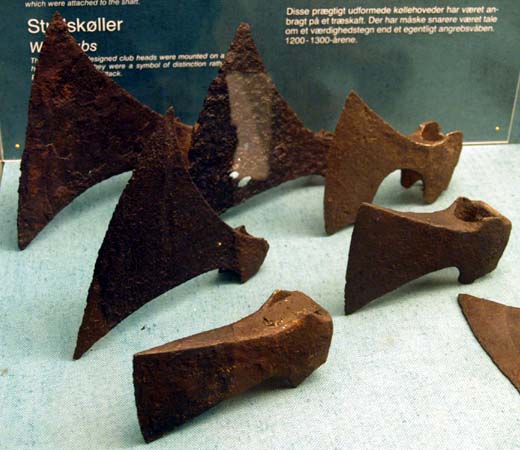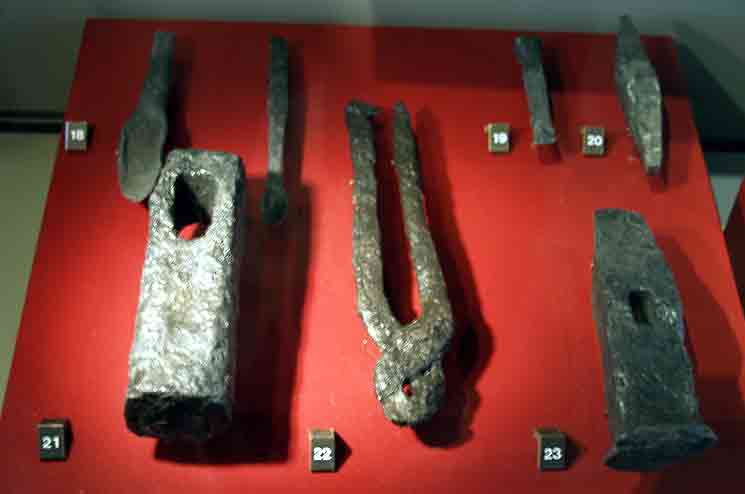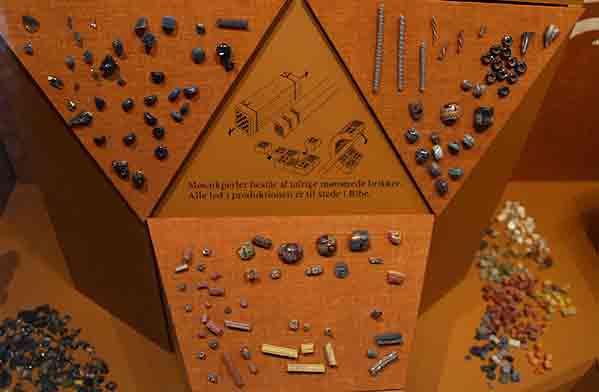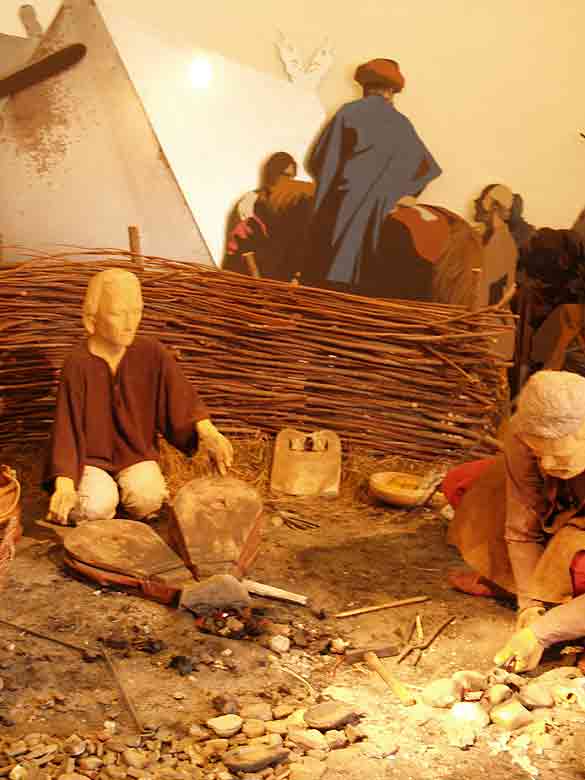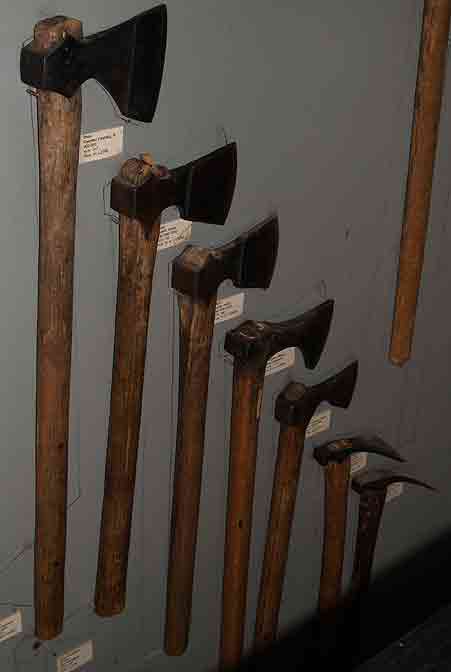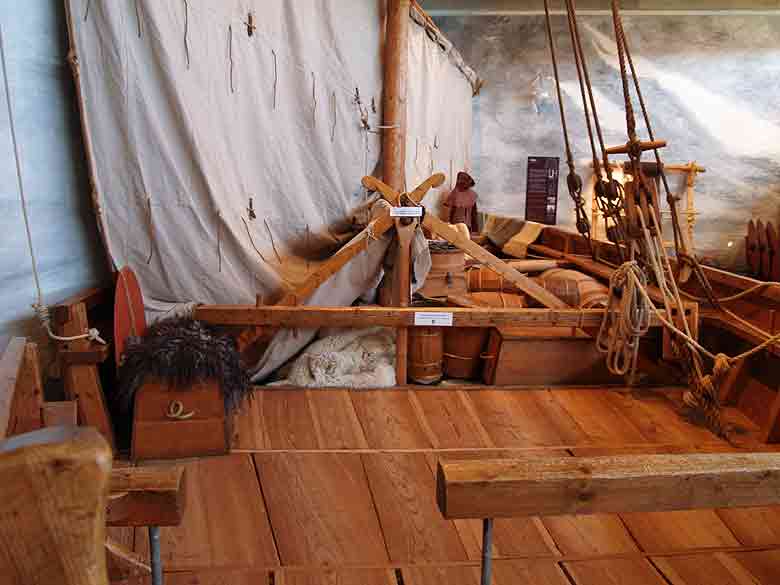On : "Viking garb accessories..belt and pouch?"
(Cross Posted from 'Hammered Out Bits')
This post is edited from my comments relating to a topic under consideration right now on NORSEFOLK . The following came in from those indicated (first names only) that bears on the topic at hand:
On this :
Note that there is an underlying philosophy to re-creating past eras at the core of this quite excellent overview (which I suggest anyone interested here reads). To paraphrase from the introduction to the article above :
Now, if you refer back to Allan's comment, you catch something else. Its a reference to a specific practical problem, what I will refer to here as a 'requirement' :
1) The structure of this group is such that there is a specific individual who serves as the arbitrator for such decisions.
2) In this specific case, a generalized ruling was under consideration. This because a specific style of object (hard leather box pouch) had grown to be used by participants, well outside what was considered suitable from the artifact record.
So the general implementation of the ruling of 'no belt pouches' was based as much on reaction to an over use of a specific type, than a general lack of artifact evidence. In the article, there is a summery of a number of available artifact prototypes, but also a quick discussion of the problems related to the preservation of certain kind of objects in the artifact record at all.
Ok - to continue:
Then there was a lot of back on forth after this, primarily directed to larger shoulder style bags, simple rectangular haversacks or 'scripts', mostly suggested made out of various fabrics. The raw volume of 'needed' objects seemed to keep growing, and thus the size of the bags ever increasing.
I'm afraid I start feeling like a 'Russian Judge' listening to this talk. More fool me, I keep wanting to direct people back to basic principles (usually followed up with some practical advice):
The simple solution is to do what they did in the Viking Age.
Have less stuff
Carry less stuff
Lock all your modern personal valuables in the car - then all you need
to have available is a single car key. That does not need to be on your
person most likely, so it can stay in your sea chest.
Modern Wallet? Like - why? You don't need your ID on you, credit cards
are useless at the event. Cash does not take up too much space. Norse
with a cell phone - you are kidding, right?
I have a real small pouch for the belt. Its maybe 3 x 4 inches. It holds
my asthma inhaler (always) eye glasses (sometimes), watch (very rarely)
and sometimes that single car key. There would be room for folding money (as if I ever had any anyways.) What else do you REALLY need?
If I might suggest : Shedding modern gadgets is part of integrating into
a historic characterization....
(round two)
First - A common solution observed from Settlement Era events (both men and women) :
Remember those old hippy bic lighter 'pouch on a thong' things? I've seen women wear a small asthma inhaler size pouch (like about 1 1/2 x 2 inch) pouch around
their necks - which (for many) just fits down the cleavage. This is big enough for an inhaler, that key, some folded paper money.
Second - No reason not to steal ideas from other time periods :
In the early 1800's (at least in Upper Canada) women could wear a flat fabric 'pocket' on a flat ribbon of cloth that tied around the waist and under the apron. Take two pieces of cloth and sew them around the edges. (The prototypes are oval, with a slit at the top for access) This allowed them to hold and carry some personal items.
Third - I do NOT want to get into a bitch slap with the costume people.
There are a number of underlaying core assumptions being made by many people on this topic - maybe without them realizing it:
1) Are the limited historic evidence of (women's) clothing in any way accurate to 'real' life?
2) Are those evidences only relevant to specific class / wealth / situation?
These two are of primary significance to this whole conversation.
- The illustrations are by their very nature cartoon like. They are almost always A) physically small and B) rendered in media that do not allow detail. I defy anyone looking at a one inch high silver token of a woman to make out anything more than the most general outlines. Much less if there is a small flat pouch under an apron.
- Burials are NOT representational of daily life. Do modern people get buried with their driver's licences and medications stuffed in pockets? Does anyone really carry a cell phone in their wedding dress?
Fourth (key) - What depth of re-creation is any individual able / willing / intending to maintain?
A number of people mentioned (thank you) that there is a balance to be made between a modern reality and a historic accuracy. If you REALLY are trying to duplicate the 1000 AD Norse - you just DO NOT have a cell phone! I'm afraid the whole conversation was degrading into an argument about 'having your cake and wanting to eat it too' ... but at the same time 'not having anyone see you carry it around with you in the mean time'.
Now, anyone who has been following this Blog (or check the links please) , I primarily operate at a fairly professional level in terms of historic interpretation. Please remember that this informs my point of view and comments.
Some more advice, from (considerable) experience in designing museum interpretive programs, which often have to deal with the same root problems:
- Staff are modern people who live in the 21st Century (they just work in the 'past')
- Some modern objects are required on hand for security, safety, etc
- The general public often has considerable access to the presentation area (if only when someone's back is turned).
There are a number of ways to create 'passive security' for equipment.
- Use of simple fabric / leather bags or closed baskets to hold and cover modern objects that need to be close to hand / be highly portable (this discussed recently at some length)
- Use of smaller wooden chests (small sea chest from Oseberg the ideal prototype) The easiest way to secure this is simply to use it as a seat.
- Obstruct entry ways to tents etc by placing chests / shields / buckets, etc across entrances. In practice, most people will not actually enter a space they have to 'crawl over' to get into.
- Away from camp? Slide the sea chest so its under the edge of a bed. Or place something heavy on top of it (say a shield). Or put a lot of simple smaller stuff on top. You'd be surprised how the remains of a lunch (crust of bread on a wooden trencher) set on a sea chest will keep people from trying to open a box.
- Away from your spot at the fire? A loop of rope tied around the sea chest will act as a simple restriction to access.
Yes, I KNOW we can all supply stories of nervy people who will poke into almost anything. I KNOW there is little you can do to stop someone seriously intending to steal things.
Truth is - anything so valuable that its theft represents serious loss - is just plain best left at home, or locked in the car. (If its not secure locked in the car, then you OBVIOUSLY should have left it at home!) If you decide to bring it and then carry it with you, just put up with the fact that you will just NOT resemble someone from 1000 AD at the market (who never had a camcorder in the first place).
If someone moves my sea chest to get it open, then complains about my modern first aid kit inside?
It says a heck more about THEM than it does about ME.
Those who are interested in this whole aspect of historic re-creation, might want to read my 1998 paper :
Lessons from the Viking Age - Development of an Interpretive Program for L' Anse aux Meadows NHS
(I once worked with just one other interpreter inside a camp presentation which was visited by 8,000 people over six hours)
Darrell
This post is edited from my comments relating to a topic under consideration right now on NORSEFOLK . The following came in from those indicated (first names only) that bears on the topic at hand:
Is it standard to wear a belt w/pouch over a woman's apron dress? ... Proper styles? I'm putting together my first viking garb outfit.
Svana
A nice article on the pouch controversy comes from a Regia group,
Guerin y Gwyr: http://www.gwerin.org.uk/articles/pouches.htm
Folo
As one of the main authors of the article on pouches within Regia that
Guerin y Gwyer have posted on their website.
I would like to point out this was a bit of research done when the
Authenticity officer was planning a total ban on pouches within the society
( due to the large number of painted hard leather "cartridge box" style
pouches).
Myself and Andy and Gary ( surnames removed) were acting as Devils advocates and pointing to evidence of some types of pouches in period in the UK. Including evidence pointing towards fabric pouches being use in the UK.
Allan
On this :
Note that there is an underlying philosophy to re-creating past eras at the core of this quite excellent overview (which I suggest anyone interested here reads). To paraphrase from the introduction to the article above :
' ... the Code of Law is organised so the argument for (the use of any object) bears the burden of proof. We must prove our case (for the inclusion of the object) rather than the Authenticity Officer proving his (reasons for removing it). Since its inception it has been accepted by the authenticity department that three provenances are regarded as sufficient proof for the use of a period item in a Regia context. 'So this is the core principle adopted by Regia to regulate what objects might be included for use in any of their presentations. On the face of it, very good - seems clear and easy to understand. Notice that it specifically relates to the individual historic focus of Reiga Anglorum itself. They describe themselves : "Regia Anglorum attempts to recreate a cross section of English life around the turn of the first millennium. Our actual self imposed brief is AD950 - 1066..."
Now, if you refer back to Allan's comment, you catch something else. Its a reference to a specific practical problem, what I will refer to here as a 'requirement' :
"... the Authenticity officer was planning a total ban on pouches within the society ( due to the large number of painted hard leather "cartridge box" styleSo two things are pointed up here.
pouches)."
1) The structure of this group is such that there is a specific individual who serves as the arbitrator for such decisions.
2) In this specific case, a generalized ruling was under consideration. This because a specific style of object (hard leather box pouch) had grown to be used by participants, well outside what was considered suitable from the artifact record.
So the general implementation of the ruling of 'no belt pouches' was based as much on reaction to an over use of a specific type, than a general lack of artifact evidence. In the article, there is a summery of a number of available artifact prototypes, but also a quick discussion of the problems related to the preservation of certain kind of objects in the artifact record at all.
Ok - to continue:
Then there was a lot of back on forth after this, primarily directed to larger shoulder style bags, simple rectangular haversacks or 'scripts', mostly suggested made out of various fabrics. The raw volume of 'needed' objects seemed to keep growing, and thus the size of the bags ever increasing.
I'm afraid I start feeling like a 'Russian Judge' listening to this talk. More fool me, I keep wanting to direct people back to basic principles (usually followed up with some practical advice):
The simple solution is to do what they did in the Viking Age.
Have less stuff
Carry less stuff
Lock all your modern personal valuables in the car - then all you need
to have available is a single car key. That does not need to be on your
person most likely, so it can stay in your sea chest.
Modern Wallet? Like - why? You don't need your ID on you, credit cards
are useless at the event. Cash does not take up too much space. Norse
with a cell phone - you are kidding, right?
I have a real small pouch for the belt. Its maybe 3 x 4 inches. It holds
my asthma inhaler (always) eye glasses (sometimes), watch (very rarely)
and sometimes that single car key. There would be room for folding money (as if I ever had any anyways.) What else do you REALLY need?
If I might suggest : Shedding modern gadgets is part of integrating into
a historic characterization....
(round two)
First - A common solution observed from Settlement Era events (both men and women) :
Remember those old hippy bic lighter 'pouch on a thong' things? I've seen women wear a small asthma inhaler size pouch (like about 1 1/2 x 2 inch) pouch around
their necks - which (for many) just fits down the cleavage. This is big enough for an inhaler, that key, some folded paper money.
Second - No reason not to steal ideas from other time periods :
In the early 1800's (at least in Upper Canada) women could wear a flat fabric 'pocket' on a flat ribbon of cloth that tied around the waist and under the apron. Take two pieces of cloth and sew them around the edges. (The prototypes are oval, with a slit at the top for access) This allowed them to hold and carry some personal items.
Third - I do NOT want to get into a bitch slap with the costume people.
There are a number of underlaying core assumptions being made by many people on this topic - maybe without them realizing it:
1) Are the limited historic evidence of (women's) clothing in any way accurate to 'real' life?
2) Are those evidences only relevant to specific class / wealth / situation?
These two are of primary significance to this whole conversation.
- The illustrations are by their very nature cartoon like. They are almost always A) physically small and B) rendered in media that do not allow detail. I defy anyone looking at a one inch high silver token of a woman to make out anything more than the most general outlines. Much less if there is a small flat pouch under an apron.
- Burials are NOT representational of daily life. Do modern people get buried with their driver's licences and medications stuffed in pockets? Does anyone really carry a cell phone in their wedding dress?
Fourth (key) - What depth of re-creation is any individual able / willing / intending to maintain?
A number of people mentioned (thank you) that there is a balance to be made between a modern reality and a historic accuracy. If you REALLY are trying to duplicate the 1000 AD Norse - you just DO NOT have a cell phone! I'm afraid the whole conversation was degrading into an argument about 'having your cake and wanting to eat it too' ... but at the same time 'not having anyone see you carry it around with you in the mean time'.
Now, anyone who has been following this Blog (or check the links please) , I primarily operate at a fairly professional level in terms of historic interpretation. Please remember that this informs my point of view and comments.
Some more advice, from (considerable) experience in designing museum interpretive programs, which often have to deal with the same root problems:
- Staff are modern people who live in the 21st Century (they just work in the 'past')
- Some modern objects are required on hand for security, safety, etc
- The general public often has considerable access to the presentation area (if only when someone's back is turned).
There are a number of ways to create 'passive security' for equipment.
- Use of simple fabric / leather bags or closed baskets to hold and cover modern objects that need to be close to hand / be highly portable (this discussed recently at some length)
- Use of smaller wooden chests (small sea chest from Oseberg the ideal prototype) The easiest way to secure this is simply to use it as a seat.
- Obstruct entry ways to tents etc by placing chests / shields / buckets, etc across entrances. In practice, most people will not actually enter a space they have to 'crawl over' to get into.
- Away from camp? Slide the sea chest so its under the edge of a bed. Or place something heavy on top of it (say a shield). Or put a lot of simple smaller stuff on top. You'd be surprised how the remains of a lunch (crust of bread on a wooden trencher) set on a sea chest will keep people from trying to open a box.
- Away from your spot at the fire? A loop of rope tied around the sea chest will act as a simple restriction to access.
Yes, I KNOW we can all supply stories of nervy people who will poke into almost anything. I KNOW there is little you can do to stop someone seriously intending to steal things.
Truth is - anything so valuable that its theft represents serious loss - is just plain best left at home, or locked in the car. (If its not secure locked in the car, then you OBVIOUSLY should have left it at home!) If you decide to bring it and then carry it with you, just put up with the fact that you will just NOT resemble someone from 1000 AD at the market (who never had a camcorder in the first place).
If someone moves my sea chest to get it open, then complains about my modern first aid kit inside?
It says a heck more about THEM than it does about ME.
"Re-creating History is the Art of the Possible"
Those who are interested in this whole aspect of historic re-creation, might want to read my 1998 paper :
Lessons from the Viking Age - Development of an Interpretive Program for L' Anse aux Meadows NHS
(I once worked with just one other interpreter inside a camp presentation which was visited by 8,000 people over six hours)
Darrell
Labels: commentary, historic intepretation










